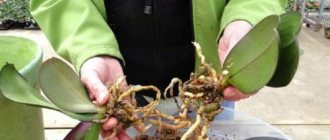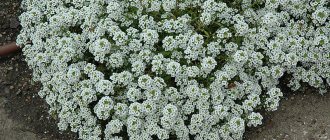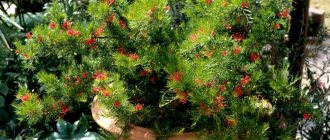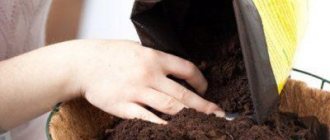Phalaenopsis is one of the most spectacular orchids. Most people, seeing the lush flowering and unusual coloring of butterfly flowers, want to place the same specimen on their windowsill, which means the question arises of how this plant reproduces.
Like most plants, phalaenopsis reproduces by seeds and vegetatively , but there are features that make this process difficult.
Plucking and rooting a leaf, like a violet, or cutting a cutting will not work, because the methods of propagating phalaenopsis are very different from those used for most indoor plants . Therefore, below we will tell you how to propagate phalaenopsis with step-by-step photos.
Comparison of outdoor and indoor plants
When growing a plant outside, it will reproduce in two ways, but indoor flowers have many more of them.
In nature, phalaenopsis reproduce quite interestingly - with the wind, the pollen located in the seed capsules is carried and deposited in different places. In addition, the flower emits an amazing aroma, which attracts various insects. Once the seeds of a plant have fallen to the ground, they cannot just germinate; they need soil fungi to receive carbohydrates from them for germination and development. The next way to propagate phalaenopsis in nature is to form new layerings and shoots after flowering . Both methods: seeds and shoots work great. But propagating a home flower by seeds is quite problematic and it is not always possible to get a healthy plant.
Phalaenopsis flowering, how to stimulate flowering
An orchid can bloom at any time of the year, it all depends on the general condition of the plant and growing conditions. Within one year, a phalaenopsis bush can bloom 2 times, and if the orchid is grown in favorable conditions, it can bloom 3 times. Flowering duration ranges from 2 to 6 months.
Phalaenopsis pulchra. ©sunoochi
Growing methods and their description
Phalaenopsis reproduces in the following ways:
- By cuttings . For this method, a flower arrow is used, which is cut into cuttings with dormant buds. They are then rooted to create new plants.
- Bush division . The essence of this method is to divide the mother plant into 2 parts. The upper part is cut off and rooted separately, while the lower part continues to grow on its roots and dormant buds awaken in the axils of its leaves.
- Children . This method involves using awakened buds that form and form small orchids. They need to be separated from the parent plant and planted in separate containers.
- Seeds . This method requires creating sterile conditions, but then a plant can grow whose flowers will differ from the parent orchid in color and shape.
Orchid propagation by separation of children
Quite often, after flowering, you can see the development of new plants on the peduncles in the axils - these are “babies”. It is quite easy to propagate phalaenopsis with their help. As soon as 2-3 leaves have appeared on the new plant, for the roots to appear, the base of the rosette must be covered with a small amount of sphagnum and tied with thread or wire. Periodically moisten the sphagnum with a spray bottle. When the roots reach a length of several centimeters, use a sharp sterile knife or pruning shears to separate the baby along with a small part of the old peduncle. After treating the cuts with charcoal powder, carefully plant the young plant in a substrate of small fraction bark mixed with pieces of charcoal. Cover the upper part of the substrate with sphagnum moss. Planted children must be kept in a greenhouse with constant, fairly high humidity. The temperature should be at least +22…+25 °C, and you should not forget about ventilating the greenhouse. During the first days, it is better not to water the plants, but only lightly spray them. The plant on which babies form after flowering requires feeding with a special fertilizer for orchids.
Does the plant need to be stimulated?
Sometimes orchids are able to produce babies without intervention. In this case, you just need to watch them until they form 2 pairs of young leaves. After this, aerial roots are formed, and when their length reaches 5 cm, they can be carefully separated.
If this process does not occur, then you need to stimulate the plant, following the following action plan:
Remove the scales as carefully as possible so as not to injure the dormant buds.- Apply a small amount of cytokinin ointment to them.
Hormonal paste can be purchased at the store or prepared at home using the following ingredients:
- kinetin – 10 mg;
- water – 1 ml;
- lanolin – 1 g.
All ingredients must be mixed thoroughly until the mixture becomes homogeneous and its color is white.
Quite often, only one side shoot is formed during propagation . To prevent this, you need to place the flower in a greenhouse where the temperature is not lower than 28 degrees Celsius. The plant should be in the greenhouse for 5 days, and after that it can be treated with paste.
We invite you to watch a video about the use of cytokinin ointment on orchids:
Proper care of an orchid
The orchid needs to be provided with a little rest; for this, it is placed in a separate place from all plants so as to avoid direct rays of the sun. At this time, the flower is not fed or watered, but simply monitored so that various pests do not appear. The flower is left in this state for two weeks, and then the flower is gradually accustomed to watering and lighting.
Proper lighting is also necessary; it must be enough, otherwise the leaves will become light and then turn yellow. The orchid must be positioned so that it receives a lot of diffused light, without direct rays of the sun. In summer, the bush is darkened a little; a matte film is used for this. Since there is not much sunlight in autumn, the film can be removed; during this period the plant goes into a dormant state. In winter, daylight hours should be about 12 hours, otherwise additional lighting with lamps is used.
When growing an orchid, the correct air temperature is observed; a favorable indicator should be from 18 to 27 degrees Celsius during the daytime, and 24 degrees at night. In winter, the flower does not need frequent watering, since the plant does not need high humidity. Watering is carried out as the soil dries out.
When properly planted, the orchid quickly takes root and develops well. The plant should not be planted during flowering. A leaf appears in the middle of the flower, which is then torn off; this is the baby for reproduction. Cuts should be treated with cinnamon or charcoal to avoid rotting.
The orchid is an unusual beautiful plant that can decorate a room or windowsill with its blooms. Flower propagation can occur in several ways, suitable for different varieties separately. With proper division of the bush, the plant will fully develop, and the young flower will replenish the collection of orchids. After transplantation, the young plant needs proper care, temperature control, lighting, and watering.
Recommendations
How to determine that a flower is ready to reproduce?
Phalaenopsis can only be propagated using an adult plant. It should form 5 healthy leaves, develop a root system, and the flower should be at least 3 years old.
Preparing an orchid for reproduction lasts about 2 weeks. Its essence is as follows:
- Place the plant in a place well lit by sunlight, but it should be diffused and not direct.
- Stop watering for this time, arrange a temperature difference so that it is 28 degrees during the day and 15-16 degrees at night.
- Carefully observe the root system; if it has turned silver instead of green, then wait another 2-3 days; water only when the flower is ready to reproduce.
What sprouts do phalaenopsis have?
Depending on how the orchid gave birth to the baby, babies are classified as:
- baby on the trunk;
- root baby;
- division;
- seedlings.
We will not consider the process of development and care of seedlings and cuttings, since in the first case this process is quite labor-intensive and lengthy, and in the second we will talk about the resuscitation of the plant.
In general, the young orchid on the peduncle and at the base looks the same, both of them can bloom while still on the mother plant, but there is still a difference in how to care for the baby phalaenopsis orchid. It’s quite easy to do this at home, the main thing is to know their features.
Radical baby: developmental features
As already mentioned, such a baby appears in extreme conditions for the mother plant. The appearance of a root baby is always a reason to reconsider the conditions of keeping your tropical beauties.
Important! If your blooming orchid produces offspring, this does not mean that it is good! Perhaps she takes advantage of every opportunity to reproduce.
Another reason for the appearance of a baby on the orchid trunk is flowering from the growth point of the mother plant. After releasing the peduncle from this place, the phalaenopsis will no longer be able to grow new leaves, and in order to extend its life cycle, it can give birth to offspring.
The basal children of the phalaenopsis orchid develop rather slowly. In the first few weeks they produce 2-3 leaves, which will develop over 3-4 months. The growing body receives nutrients from the mother, therefore, you need to pay attention to the condition of the root system.
The roots should be green when moistened or silvery when dry; a good sign is the appearance of bright green tips, indicating the development of the plant. The mother's leaves should have good turgor and have neither dry nor wet spots.
Unlike stem children, root children do not need to be planted, but we will talk about this a little later.
Features of the stem baby
Before you think whether it is already possible to separate the baby from the mother orchid, you need to know when it will be able to exist separately:
- Stem babies should grow roots 5 cm or more in length.
- A young orchid on a peduncle should have at least 3 leaves, measuring 5 cm or more.
Next, we’ll talk about how to raise a baby phalaenopsis orchid in order to remove it from its mother as quickly and correctly as possible.
How to propagate an orchid?
Cuttings
The method of propagating orchids by cuttings is the simplest and does not require much time and attention. It is carried out as follows:
- It is necessary to cut off a side shoot from the mother plant; its length should be within 10-15 cm.
- Place the planting material on a moistened soil surface and cover it with a plastic bag, building a small greenhouse.
- Wet sand or sphagnum is suitable as soil.
- When cutting cuttings, it is important that each has 2 nodes with axillary buds. In addition, the lower buds of the peduncle are the strongest.
Seeds
Propagation of orchids by seeds at home is used extremely rarely, since this method is very complicated. For these purposes, it will be necessary to create an artificial nutrient medium. It is in it that the planting material will remain until germination. This may take 3-9 months. But it is difficult to maintain complete sterility here, since it is simply impossible to get rid of mold fungi.
When the seeds germinate, they must be kept under certain conditions for 3 years, and only then planted in a permanent place. You can expect phalaenopsis to bloom in 2 years.
Children
This method of orchid propagation is the most optimal. Its essence is that plant children grow from dormant buds . They are formed on the peduncle and on the stem of the plant. Sometimes this happens on its own, but most often it is necessary to carry out stimulation artificially.
You can do this in several ways:
- division of the mother plant;
- drying of the earthen coma and temperature changes;
- use of a hormonal stimulant;
- division of the peduncle.
An adult orchid can be divided if it is completely healthy . It must have powerful aerial roots and at least 7 leaves.
The procedure is as follows:
Using a sharp knife, cut off the top.- Treat the cut area with activated carbon powder.
- Divide so that the lower part of the flower has aerial roots (at least 3-4) and several leaves (3-4).
- Transplant the cut part into another container for rooting. On the lower part, after some time, babies form from the sinuses.
- As soon as the length of the root system is 5-6 cm, the plants can be removed and planted.
We invite you to watch a video about separating a baby from an orchid:
By division
The division method is simple, but it is suitable for adult phalaenopsis . To do this, several conditions must be met:
a powerful rosette containing at least 6 leaves;- aerial roots (2-3), which should be well developed.
Procedure:
- Using a sharp knife, cut off the top of the plant so that there are 3-4 leaves and aerial roots.
- Treat the cut areas with activated carbon powder and plant the cuttings in the prepared substrate.
- The lower part of the mother bush should be in its own pot.
- You can also plant aerial roots in a separate container, but their length should be more than 5 cm.
We invite you to watch a video on how to propagate an orchid by division:
Peduncle
This is another simple method that is carried out according to the following plan:
- When flowering ends, remove the peduncle at the very base.
- Immediately divide it into several parts of 3-4 cm.
You need to make sure that each part has one dormant bud, and it should be located in the middle of the cutting. - The cut must be treated with crushed coal.
- Place the cuttings in moistened sphagnum moss and build a mini-greenhouse.
- At a temperature of 25-28 degrees, the cuttings will produce roots, only the air under the film must be moist.
Roots
Even a beginner can do this method of reproduction:
- Lift the plant above the pot and carefully remove it from the soil.
- Cut the rhizome with a sterile knife, leaving 2-3 pseudobulbs and a sprout.
- Sprinkle the cut area with crushed coal.
- Transplant each division into a separate pot with fresh soil. Spray it 2 times a day until real leaves and good roots appear.
Reproduction of phalaenopsis by seeds
This method is quite labor-intensive. Pollination of a flower does not cause problems for anyone. The fruits ripen for about 3–6 months – that’s when the main difficulties appear. After all, you cannot sow an orchid, like, for example, lettuce or radishes. Its seeds are so small that they resemble dust. They are deprived of nutrients, and the embryo is greatly reduced. Therefore, such seeds need to be sown on an agar-based nutrient medium. It is necessary to create absolute sterility so that subsequently there is no contamination of the environment and seeds, which will lead to their death. You will have to be patient, because their germination is a long process, and even if you successfully obtain small plants, you will have to wait for more than one year for the first flowering.
Photo
Below are step-by-step photos showing how a home orchid propagates.
Bush division
One of the most difficult methods, which also poses a danger to the plant, is dividing the bush. Inexperienced gardeners often make mistakes when carrying out this procedure, which leads to the death of the plant.
Important! Dividing the bush is carried out in conditions of low contamination of the environment and with a sterile instrument.
The selected flower must be large and absolutely healthy. Using a sharp and sterile knife, divide the plant in two. Leaves and roots should remain on each half of the bush. The sections are treated with charcoal and antiseptic agents. The mother flower is left in the same pot, and a new substrate is prepared for the seedling. The soil is specially prepared. Sterilize, then dry and only then mix.
At first, do not water abundantly. Temperature conditions and humidity are chosen as standard for the orchid family and the length of daylight is increased.
How to care?
Humidity
For phalaenopsis, a humidity of 50-80% is considered ideal . A humidity of 25-85% is possible, but then the development of diseases, especially fungal ones, cannot be ruled out.
Temperature
A temperature of 28-30 degrees is ideal for flower propagation.
Indicators may rise above the norm, but not below.
The soil
You can prepare the nutrient substrate yourself using small pieces of pine bark - 0.5-1 cm, and also take the same amount of soil from the mother pot.
Watering
Watering phalaenopsis must be done regularly, avoiding standing water and drying out. To moisten the soil, use settled and warm water. Pour it strictly at the root.
Reproduction of phalaenopsis is a responsible process that requires special attention and labor. When choosing the appropriate method, several points need to be taken into account, but novice gardeners are better off resorting to propagation by peduncles or dividing the bush. And in order for the plant to please with its active growth and beautiful flowering, you need to create adequate conditions and regularly care for it.
How to use cytokinin paste
As practice shows, it is best to use this product at low temperatures and in the summer. Moreover, before using the drug, you must make sure that the plant is completely healthy and that it has at least five leaves. The instructions for use of this product say that it cannot be used during the flowering of phalaenopsis.
To stimulate the formation of children for orchid propagation, it is necessary to create the most comfortable temperature conditions for the plant, which provide for the complete absence of temperature changes and keeping the plant in an atmosphere where the thermometer will not be below +30-32 degrees.
The paste should be applied only to the upper and lower dormant buds of the peduncle, in a small amount (at the tip of a match).
Some experts in the matter of propagating orchids by children note that a week before starting to treat the plant with this paste, the phalaenopsis should be sprayed with a solution containing nitrogen fertilizer. Practice shows that with proper use of the product, the plant begins to produce babies within a couple of weeks.











